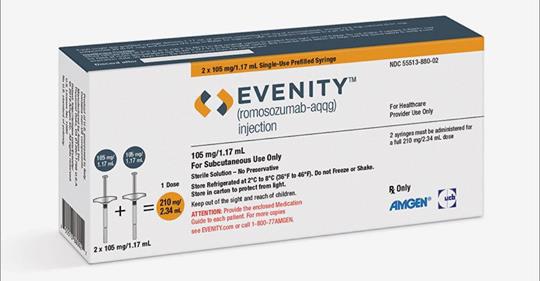The US Food and Drug Administration (FDA) has approved the humanized monoclonal antibody romosozumab (Evenity, Amgen) for treatment of osteoporosis in postmenopausal women with a history of osteoporotic fracture or multiple risk factors for fracture, or those who have failed or are intolerant to other osteoporosis therapies.
Earlier this year, the FDA's Bone, Reproductive and Urologic Drugs Advisory Committee voted 18-1 in favor of romosozumab for this indication, as reported by Medscape Medical News.
One dose of romosozumab consists of two injections, one immediately following the other, given once a month. The bone-forming effect of the drug wanes after 12 doses so more than 12 doses should not be used, the FDA said. "If osteoporosis therapy is needed after the 12 doses, patients should begin an osteoporosis treatment that reduces bone breakdown," they advise.
Romosozumab "provides women with postmenopausal osteoporosis who are at high risk of fracture with a new treatment that will reduce this risk," Hylton V. Joffe, MD, director of the Center for Drug Evaluation and Research's Division of Bone, Reproductive and Urologic Products, said in a news release.
Joffe cautioned, however, that because romosozumab may increase the risk for heart attack, stroke, and cardiovascular death, "it's important to carefully select patients for this therapy, which includes avoiding use in patients who have had a heart attack or stroke within the previous year." The risk for cardiovascular events is included in a black box warning on the label.
"Health care professionals should also consider whether the benefits of Evenity outweigh its risks in those with other risk factors for heart disease and should discontinue Evenity in any patient who experiences a heart attack or stroke during treatment," the FDA said.
On its first pass for approval in July 2017, the FDA rejected romosozumab and requested more data on cardiovascular risk.
Romosozumab inhibits sclerostin, a protein expressed in osteocytes, whose main function is to block bone formation.
The safety and efficacy of romosozumab were demonstrated in two clinical trials involving more than 11,000 women with postmenopausal osteoporosis.
In the first trial, 1 year of treatment with romosozumab lowered the risk for a new vertebral fracture by 73% compared with placebo. This benefit was maintained over the second year of the trial when romosozumab was followed by 1 year of denosumab compared with placebo followed by denosumab.
In the second trial, 1 year of romosozumab followed by 1 year of alendronatereduced the risk for a new vertebral fracture by 50% compared with 2 years of alendronate alone. Romosozumab followed by alendronate also reduced the risk for nonvertebral fractures compared with alendronate alone.
Common side effects of romosozumab include joint pain, headache, and injection site reactions.






 留言列表
留言列表
 線上藥物查詢
線上藥物查詢 